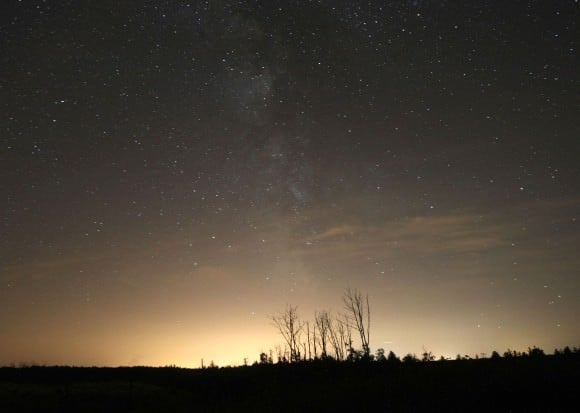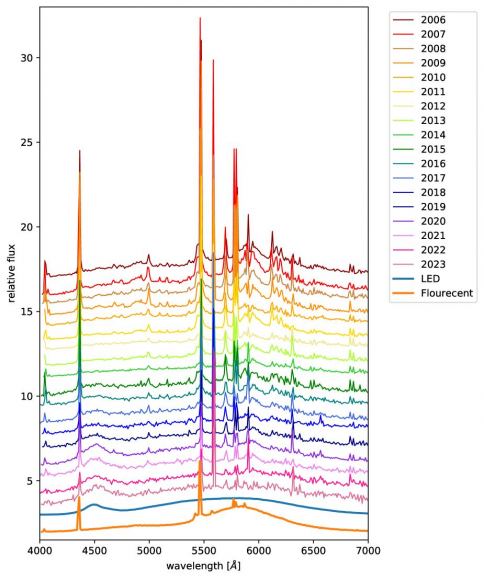Light pollution ruins dark skies. It's a scourge that ground-based observatories have to deal with in one form or another. Scientists used a small observatory in Japan to measure what changed when a nearby town improved its lighting practices. They also noted the challenges it still faces.
Bisei Town lies in a semi-rural area in the southwestern part of Okayama Prefecture in Japan. It's a designated dark sky place and the locals are adamant about keeping their view of the stars. However, they still have to contend with light pollution from other cities in the region. The town itself has several astronomical observation posts, including the Bisei Astronomical Observatory. That facility sports a 101-cm telescope, along with smaller instruments, and is open to the public for sky viewing year-round.
The town enacted light pollution ordinances in 1989, making it the first local government in Japan to pass such a law. Several years ago, the town and observatory, along with other partners, worked with Panasonic to create a dark sky-friendly region. As part of the effort, the town replaced all its public lighting with LEDs that have a color temperature of 3000K or less. As a result, Bisei was certified by DarkSky International (formerly the International Dark-Sky Association) as "DarkSky Approved." However, there are still some very bright, higher-temperature LEDs still in use, particularly in neighboring towns, where the populations are a half-million or more. Their light continues to create problems.
What does Light do to Dark Skies?
In general, light pollution is a growing global problem. It dims the sky, obstructs the view, and makes life more difficult for astronomers. The most obvious effect of light pollution anywhere is its ability to wipe out the view of dim and distant objects. For visible-light observers, that means they can't detect faraway galaxies or measure variations in variable stars (for example). Astronomers who want to take spectra of specific objects often find their work "polluted" by such things as light from mercury-vapor lamps and other sources.
Light pollution affects more than the night sky, however. Study after study shows that it affects human health and safety. Ironically, one of the reasons given for increased lighting in many places is "safety". However, aiming lights willy-nilly to provide a safe place often results in light trespass. It also creates an unintended effect: bright lights aimed directly at people's eyes often blind them to dangers hidden in shadows, or to cars and pedestrians on brightly lit streets. In addition, light pollution has definite effects on other forms of life, from migrating birds to ocean populations.
A short video showing how lighting can actually provide the opposite of safety. Courtesy: DarkSky.org.In recent decades, organizations such as DarkSky International, the American Astronomical Society, and the International Astronomical Union have been joined by architects, safety officials, and others to work on solutions to light pollution. For some places, that works very well and dark skies are returning while maintaining required lighting for safety. In other places, there's still a lot of work to be done. The recent rise in the use of LEDs for lighting poses some of the same problems that incandescent lighting does. Astronomers and others continue to work on recommendations for the wise use of such lighting to mitigate the problems of light pollution.
Are there Dark Skies Over Bisei?
Japanese astronomers Ryosuke Itoh and Syota Maeno decided to monitor how the light pollution ordinances in Bisei Town have affected viewing at the Bisei Observatory. The town has replaced all of the fluorescent lights with LED lamps, which they hoped would reduce sky brightness in the nearby region. However, light pollution from these and lights farther away is still scattered by the atmosphere, which can result in a perceptible sky glow.
Sky brightness is one way of determining the effects of light pollution. It can be measured in several ways. One is to photograph the entire sky with an all-sky lens-equipped camera. That gives you a wide-angle view. Another way is to use a CCD camera attached to a telescope to get a good view of the entire sky. Finally, you can use a specially equipped sky meter that gives a photometric value to sky brightness. Itoh and Maeno used this third method to measure the skies over the Bisei Observatory. They also used sky spectra dating between 2006 to 2023 to see if the changes in lighting affected the data.
What they found with their all-sky measurements and data analysis is something of a mixed bag. Bisei Town itself now has an observed sky brightness on the Bortle Scale of class 4. That corresponds roughly to a rural/suburban transition zone. In part, the shift to lower color-temperature LEDs in place of bright incandescent lamps did reduce some light pollution in town. However, Itoh and Maeno observed a very definite spectral line around 4500 A that they call a "blue hump". It comes from the bright white, higher-temperature LEDs still in use in nearby towns, but they couldn't directly identify all the sources specifically.
Future Work
In a paper they are submitting for publication, the two scientists conclude that while Bisei Town's skies are not outstandingly dark, there is some improvement since the lighting changes were made. However, the night sky is still affected by light pollution from nearby areas, and more work needs to be done in those regions to mitigate the problem.
Most importantly, they note how important it is to separate the distinct origins of light pollution in any given area. While Bisei Town may well have improved its local environment, it still has to deal with scatted light from large metropolitan areas. Identifying those specific light pollution sources will be a big step towards helping those municipalities find ways to reduce the light pollution problems of their smaller rural neighbors.
For More Information
Long term variability of light-pollution in Bisei Town
Bisei Town, Ibara City
Video Resources about Dark Sky and Light Pollution Mitigation
 Universe Today
Universe Today


